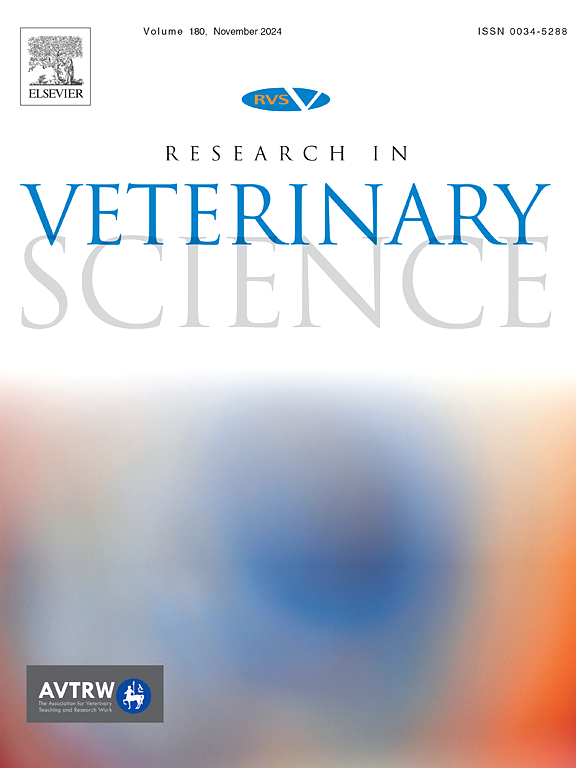瓦替诺-美托咪定-氯胺酮-丁托啡诺与美托咪定-氯胺酮-丁托啡诺联合用于新西兰大白兔肌内麻醉的比较
IF 2.2
3区 农林科学
Q1 VETERINARY SCIENCES
引用次数: 0
摘要
由于独特的生理和解剖因素,兔围麻醉期的发病率和死亡率很高。α2-肾上腺素能激动剂常用于镇静和麻醉。然而,这些药物会对心血管产生负面影响。一种经许可用于犬镇静的市售制剂(Zenalpha®)将美托咪定与瓦替诺森(一种外周作用的α2-肾上腺素能拮抗剂)联合使用。我们评估了瓦替诺桑-美托咪定联合用药(瓦替诺桑-美托咪定2mg /kg)与氯胺酮(5mg /kg)和布托啡诺(0.5 mg/kg) (ZKB)在家兔中联合用药的心肺效果和麻醉质量,并与先前描述的使用美托咪定(0.1 mg/kg)、氯胺酮(5mg /kg)和布托啡诺(0.5 mg/kg) (MKB)的肌内麻醉方案进行了比较。测量麻醉开始时间、麻醉持续时间、心率(HR)、动脉血氧饱和度(SpO₂)、体温、血压并进行比较。数据分析采用方差分析和Friedman检验(p <;0.05)。ZKB组动物的平均动脉血压显著降低(47±2 mmHg vs 71±5 mmHg), p <;0.01)和更高的心率(206±23 bpm vs 150±14 bpm, p <;0.01),与MKB组比较。与MKB组相比,ZKB组麻醉诱导时间更长(470±110 s vs 301±44 s, p = 0.03),两组麻醉时间和恢复时间相似。这些发现表明,在试验剂量下,由于其显著的降压作用,ZKB方案的临床适用性可能受到限制。本文章由计算机程序翻译,如有差异,请以英文原文为准。
Comparison of vatinoxan-medetomidine-ketamine-butorphanol and medetomidine-ketamine-butorphanol combinations for intramuscular anesthesia in New Zealand white rabbits (Oryctolagus cuniculus)
Rabbit perianesthetic morbidity and mortality are high due to unique physiologic and anatomic considerations. α2-adrenergic agonists are frequently used for sedation and anesthesia. However, these drugs can produce negative cardiovascular effects. A commercially available formulation licensed for sedation in dogs (Zenalpha®) combines medetomidine with vatinoxan, a peripherally acting α2-adrenergic antagonist. We evaluated this vatinoxan-medetomidine combination (2 mg/kg of vatinoxan-0.1 mg/kg of medetomidine) co-administered with ketamine (5 mg/kg) and butorphanol (0.5 mg/kg) (ZKB) in rabbits and compared the cardiopulmonary effects and quality of anesthesia to a previously described intramuscular anesthetic protocol using medetomidine (0.1 mg/kg), ketamine (5 mg/kg), and butorphanol (0.5 mg/kg) (MKB). Onset and duration of anesthesia as well as heart rate (HR), arterial blood oxygen saturation (SpO₂), body temperature, and blood pressure were measured and compared. Data was analyzed by using ANOVA and Friedman test (p < 0.05). Animals in group ZKB had a significantly lower mean arterial blood pressure (47 ± 2 mmHg vs 71 ± 5 mmHg, p < 0.01) and higher HR (206 ± 23 bpm vs 150 ± 14 bpm, p < 0.01) during anesthesia when compared to group MKB. ZKB anesthesia induction time was longer (470 ± 110 s vs 301 ± 44 s, p = 0.03) when compared to group MKB, while anesthesia and recovery times were similar between protocols. These findings suggest that the clinical applicability of the ZKB protocol at the tested dose may be limited due to its significant hypotensive effects.
求助全文
通过发布文献求助,成功后即可免费获取论文全文。
去求助
来源期刊

Research in veterinary science
农林科学-兽医学
CiteScore
4.40
自引率
4.20%
发文量
312
审稿时长
75 days
期刊介绍:
Research in Veterinary Science is an International multi-disciplinary journal publishing original articles, reviews and short communications of a high scientific and ethical standard in all aspects of veterinary and biomedical research.
The primary aim of the journal is to inform veterinary and biomedical scientists of significant advances in veterinary and related research through prompt publication and dissemination. Secondly, the journal aims to provide a general multi-disciplinary forum for discussion and debate of news and issues concerning veterinary science. Thirdly, to promote the dissemination of knowledge to a broader range of professions, globally.
High quality papers on all species of animals are considered, particularly those considered to be of high scientific importance and originality, and with interdisciplinary interest. The journal encourages papers providing results that have clear implications for understanding disease pathogenesis and for the development of control measures or treatments, as well as those dealing with a comparative biomedical approach, which represents a substantial improvement to animal and human health.
Studies without a robust scientific hypothesis or that are preliminary, or of weak originality, as well as negative results, are not appropriate for the journal. Furthermore, observational approaches, case studies or field reports lacking an advancement in general knowledge do not fall within the scope of the journal.
 求助内容:
求助内容: 应助结果提醒方式:
应助结果提醒方式:


